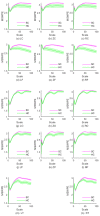Multiscale Weighted Permutation Entropy Analysis of Schizophrenia Magnetoencephalograms
- PMID: 35327825
- PMCID: PMC8946927
- DOI: 10.3390/e24030314
Multiscale Weighted Permutation Entropy Analysis of Schizophrenia Magnetoencephalograms
Abstract
Schizophrenia is a neuropsychiatric disease that affects the nonlinear dynamics of brain activity. The primary objective of this study was to explore the complexity of magnetoencephalograms (MEG) in patients with schizophrenia. We combined a multiscale method and weighted permutation entropy to characterize MEG signals from 19 schizophrenia patients and 16 healthy controls. When the scale was larger than 42, the MEG signals of schizophrenia patients were significantly more complex than those of healthy controls (p<0.004). The difference in complexity between patients with schizophrenia and the controls was strongest in the frontal and occipital areas (p<0.001), and there was almost no difference in the central area. In addition, the results showed that the dynamic range of MEG complexity is wider in healthy individuals than in people with schizophrenia. Overall, the multiscale weighted permutation entropy method reliably quantified the complexity of MEG from schizophrenia patients, contributing to the development of potential magnetoencephalographic biomarkers for schizophrenia.
Keywords: magnetoencephalogram; multiscale; schizophrenia; weighted permutation entropy.
Conflict of interest statement
The authors declare no competing interest.
Figures







References
-
- World Health Organization Schizophrenia. January 2022. [(accessed on 2 February 2022)]. Available online: https://www.who.int/news-room/fact-sheets/detail/schizophrenia.
-
- NIMH.Schizophrenia. Last Revised: May 2020. [(accessed on 2 February 2022)]; Available online: https://www.nimh.nih.gov/health/topics/schizophrenia/
Grants and funding
- BE2015700/Jiangsu Provincial Key R\&D Program (Social Development)
- BE2016773/Jiangsu Provincial Key R\&D Program (Social Development)
- 16KJA310002/Natural Science Research Major Program in Universities of Jiangsu Province
- KYCX20\_0728/Postgraduate Research \& Practice Innovation Program of Jiangsu Province
- 31671006/National Natural Science Foundation of China
LinkOut - more resources
Full Text Sources

